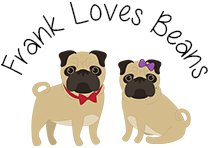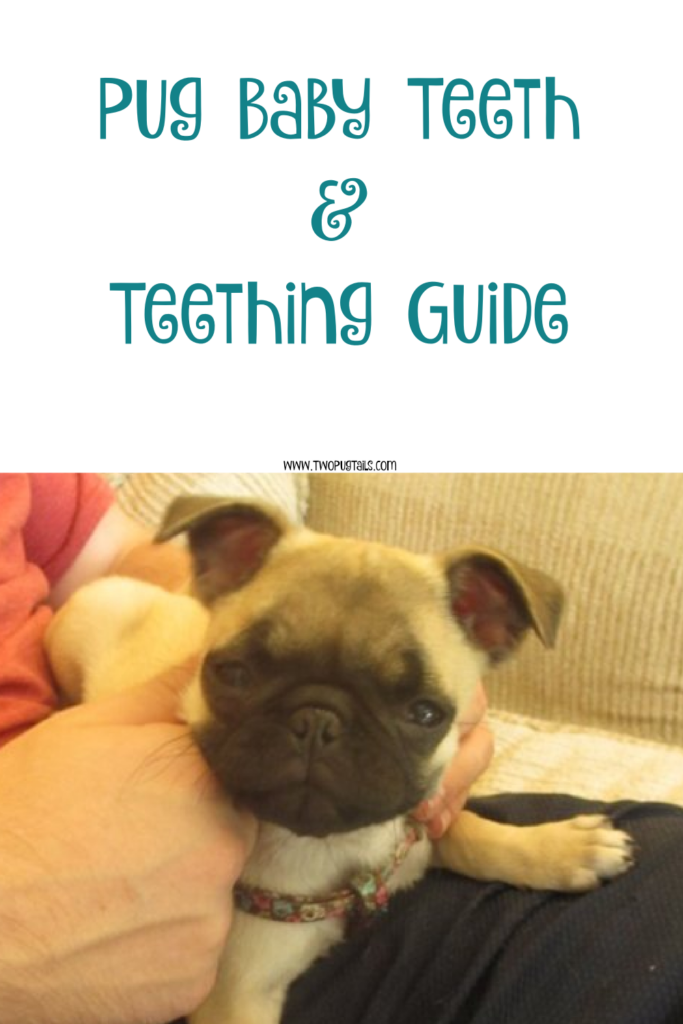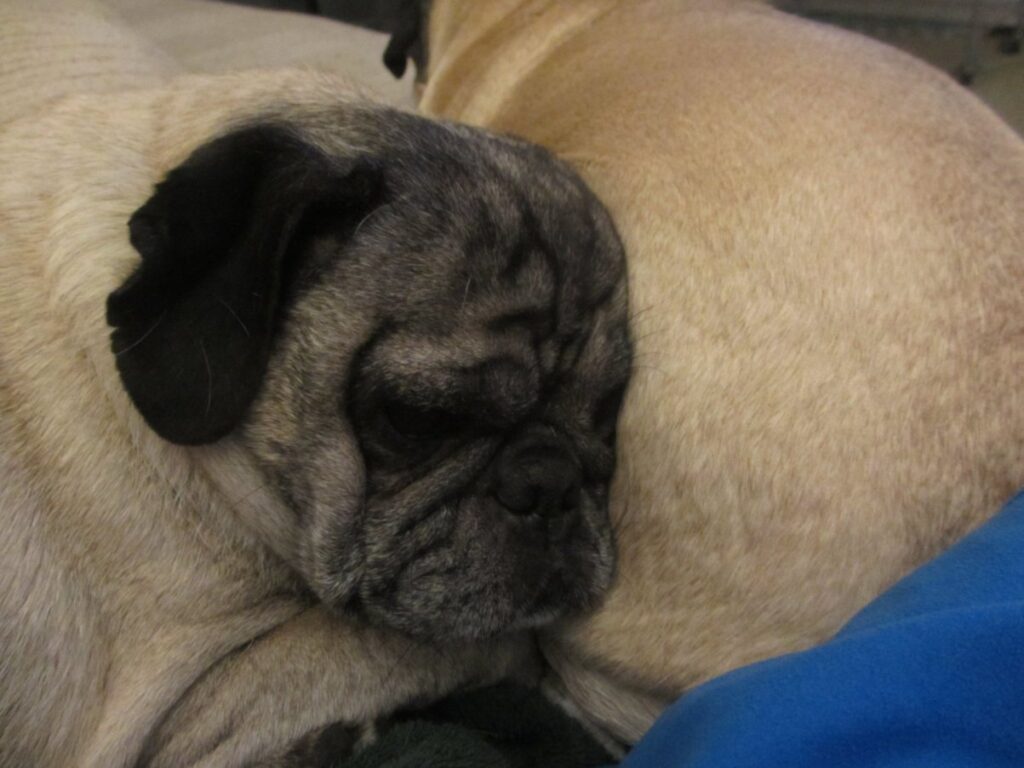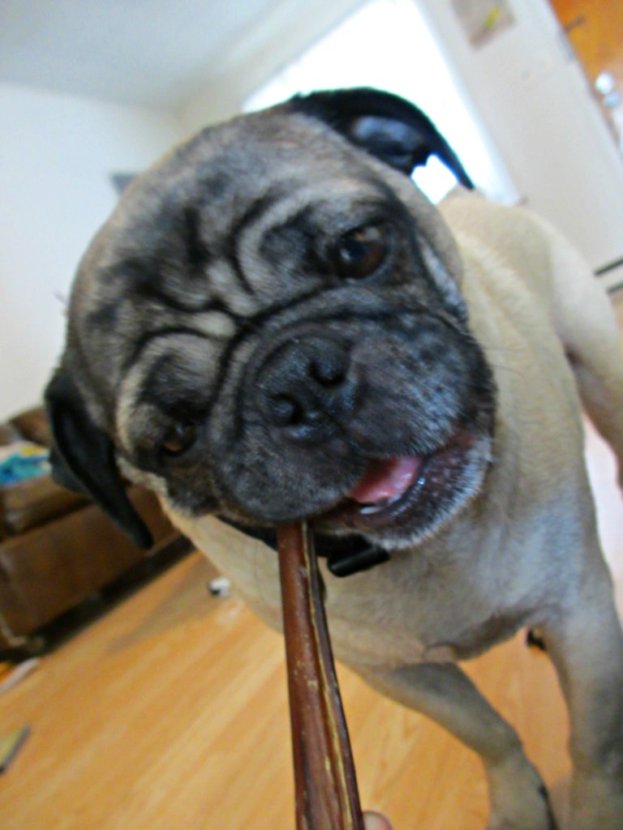
Pug Baby Teeth & Teething Guide
There are affiliate links in this post.

Pug Teething Stages
Stage 1: Milk Teeth (baby teeth) come in at 2-8 weeks old.
Pugs get their first set of teeth between 2 and 3 weeks old, around the same time that they are opening their eyes!
Typically teeth come in this order – incisors (front teeth), canine teeth, and then pre-molars. By 8 weeks of age, pug puppies should have their full set of 28 milk teeth (the dog version of baby teeth!). 8 weeks is the earliest that pugs should be removed from their mothers. Therefore, unless you’ve had one of your adult pugs get pregnant, you will likely bring your pug puppy home after they already have all of their baby teeth.
Stage 2: Teething and Losing Milk Teeth 12 weeks to 8 months.
Those milk teeth don’t hang around very long! By 12 weeks or about 3 months, puppies can begin to lose their baby teeth. Those 28 baby teeth will be replaced with 42 adult teeth by 8 months of age.
Like people, teething can happen at slightly different timeframes for different puppies. Some may have all of their adult teeth by 6 months, and some may take longer than 8 months to get their last adult teeth. It’s more of a general expectation than an absolute. It’s common for the bigger adult teeth to take longer to come in than the baby teeth took.
How Many Puppy Teeth Do Pugs Have?
Pug puppies get a set of 28 baby teeth by 8 weeks.
How Many Adult Teeth Do Pugs Have?
By 8 months of age, pugs will have their full set of 42 adult teeth.
Pug Still Has Baby Teeth
If your pug still has baby teeth after 8 months of age, it’s a good idea to check in with your vet. They may just be a late bloomer, but if their adult teeth have come through and the baby teeth are still there, the baby teeth may need pulled.
Pug Puppy Not Losing Teeth
If your pug is 4 months or older and hasn’t started losing their puppy teeth, check in with your vet. Keep in mind that your pug may lose teeth without you ever seeing their shed teeth.
If you haven’t found any baby teeth around the house, that doesn’t mean your pug hasn’t lost any. Pug baby teeth are about the size of a grain of rice, so if your pugs teeth are bigger than that, you’re likely seeing their adult teeth now.
What If Adult Teeth Come In While Baby Teeth Are Still There?
See a vet. These are called retained teeth and they are more common in brachycephalic breeds including pugs.
What If You Don’t Find Your Pugs Lost Baby Teeth?
If you know your pug has lost some teeth but you haven’t found them, don’t sweat it. It’s common for pugs to swallow their baby teeth when they fall out. They are roughly the size of a piece of rice and are unlikely to cause digestive issues.

Signs That Your Pug Is Teething:
Found teeth. You’ll find their baby teeth on the floor or elsewhere. It’s okay if you don’t, though. It’s common for dogs to swallow their baby teeth that fall out, and it doesn’t usually cause any problems.
Bleeding. You may find small amounts of blood on toys.
Extra drooling – yep, just like babies, they will drool more when their teeth are coming in.
Tons of chewing. When their gums are irritated, they want to chew chew chew!
Painful gums. Sore gums that may be darker pink or red. May be slow or hesitant to eat.
Behavior changes. Changes in mood or behavior. When your puppy is in pain, this can impact their behavior some.
Crying. May whine/cry from the pain.
Low grade fever. The inflammation caused by teething can cause a small fever in puppies.

Pug Teething Toys and Other Aids
Kong toys are great toys that are safe for dogs to chew on. Chewing on kongs can help sooth their sore gums. You can freeze some foods on kong toys (like dog-safe peanut butter) and the cold can feel good on their sore gums.
Nylabone or other chew toys. Be sure to monitor the toy to make sure you toss it out after your dog has chewed it enough. If kept for too long, they can begin to chew off pieces and that isn’t safe.
Bully sticks or himalayan chews. Rawhide is dangerous as they can cause digestive blockages. Bully sticks and himalaya chews are safer options that let dogs chew for a long time and get a treat out of it. My pugs loved best bully sticks 5-6″ bladder sticks.
Teething gel. There are some brands that make dog-safe teething gel, similar to oragel that people use on human babies. The teething gels can be rubbed on your puppy’s gums to temporarily soothe them.
Gum Massages. Sometimes just rubbing their gums can feel good to them! Of course, be careful if you’re going to do this, and be sure to wash your hands before and after.
How To Cope With ‘Naughty’ Chewing in a Teething Puppy
Remember that chewing is a need that pugs have while teething. They will be chewing on most anything they can get their teeth on, so keeping their environment safe for them is key.
Keep them safe. anything dangerous for them to chew on out of their access.
Try frozen treats, they can soothe their gums.
Give them chew toys. Chewing is a need that puppies have, so it’s important that they have some toys that they are allowed to chew on. If you catch them chewing on something they shouldn’t, swap it out with something they can chew on.
Keep them busy, both physically and mentally. Generally with pug puppies, keeping them mentally stimulated will help keep them on their best behavior as much or more than making sure they get enough exercise.
Help train bite inhibition. Teething overlaps with the time period when puppies are learning about their teeth and how they can inflict pain. One big benefit of puppies staying with their mother and littermates longer is puppies naturally teach each other that biting hurts, by yelping when they are hurt. Even if you didn’t bring your puppy home until 10+ weeks, they may still be learning that it’s not okay to bite too hard. There is a term called bite inhibition that is all about this phase where puppies learn about not biting too hard. If you’re struggling with your puppy biting you or other family members painfully (rather than softly/playfully) you’ll want to research how to train bite inhibition.
Dental health – Start young!
While it’s slightly off-topic for this post, I wanted to wrap up by encouraging good dental health habits. If you have a puppy, now is the best time to start caring for their teeth!
80% of dogs have dental health issues by 3 years of age*, so start good oral care young. It’s easiest to get dogs used to having their teeth brushed or their mouths touched if the habit is started young. Pugs are particularly prone to dental health problems because they have small mouths.
Best Pug Toothbrush & Toothpaste.
There are three popular styles of dog toothbrushes. One is a cap that goes over your finger so you can brush their teeth using your finger, another is a three-sided toothbrush that increases the odds of the bristles getting all areas of their mouth/teeth, and the third is a more traditional toothbrush shape.
I’d recommend starting with this arm & hammer pet toothbrush set because it includes the finger style brush and a traditional brush, as well as toothpaste. This way you can try both styles to see what your pug responds best to.
Many pugs have overcrowded teeth and crooked teeth which can increase their odds of developing decay and infections.

Leave a Comment